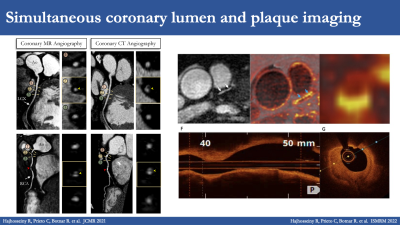Novel Contrasts & Characterizations of Coronary Architecture
1King's College London, United Kingdom
Synopsis
Coronary artery disease remains the major cause of death in many western and developing nations. Magnetic resonance imaging offers the unique opportunity to provide comprehensive evaluation of CAD as it allows to interrogate coronary luminal narrowing and detect and characterise coronary plaque both with/without contrast agents. In this presentation, I will discuss the latest developments in coronary angiography and plaque imaging and review novel endogenous/exogenous contrasts for plaque characterisation. Special focus will be given to clinical validation studies that have compared novel coronary imaging sequences with reference standards such as X-ray, computed tomography, intravascular ultrasound and optical coherence tomography.
Summary
Coronary artery disease (CAD) remains the major cause of death in many western and developing nations. Cardiac magnetic resonance imaging offers the unique opportunity to provide comprehensive evaluation of coronary artery disease as it allows to interrogate coronary luminal narrowing and to detect and characterise coronary plaque both with and without target specific contrast agents. In this presentation, I will discuss the latest developments in coronary angiography and plaque imaging and review novel endogenous and exogenous contrasts for plaque characterisation. Special focus will be given to clinical validation studies that have compared novel coronary imaging sequences with the clinical reference standards such as X-ray, computed tomography, intravascular ultrasound and optical coherence tomography.Acknowledgements
The authors acknowledge financial support from the BHF PG/18/59/33955 and RG/20/1/34802, EPSRC EP/V044087/1, EP/P001009/, EP/P032311/1, EPSRC EP/P007619, Wellcome EPSRC Centre for Medical Engineering (NS/A000049/1), Fondecyt 1210637 & 1210638, Millennium Institute for Intelligent Healthcare Engineering iHEALTH ICN2021_004.References
1) Bustin A, Rashid I, Cruz G, Hajhosseiny R, Correia T, Neji R, Rajani R, Ismail TF, Botnar RM, Prieto C. 3D whole-heart isotropic sub-millimeter resolution coronary magnetic resonance angiography with non-rigid motion-compensated PROST. J Cardiovasc Magn Reson. 2020 Apr 16;22(1):24. doi: 10.1186/s12968-020-00611-5.
2) Hajhosseiny R, Rashid I, Bustin A, Munoz C, Cruz G, Nazir MS, Grigoryan K, Ismail TF, Preston R, Neji R, Kunze K, Razavi R, Chiribiri A, Masci PG, Rajani R, Prieto C, Botnar RM. Clinical comparison of sub-mm high-resolution non-contrast coronary CMR angiography against coronary CT angiography in patients with low-intermediate risk of coronary artery disease: a single center trial. J Cardiovasc Magn Reson. 2021 May 17;23(1):57. doi: 10.1186/s12968-021-00758-9.
3) Milotta G, Ginami G, Cruz G, Neji R, Prieto C, Botnar RM. Simultaneous 3D whole-heart bright-blood and black blood imaging for cardiovascular anatomy and wall assessment with interleaved T2 prep-IR. Magn Reson Med. 2019 Jul;82(1):312-325. doi: 10.1002/mrm.27734. Epub 2019 Mar 21.
